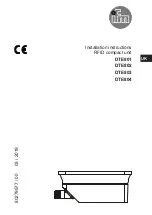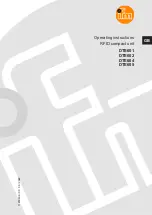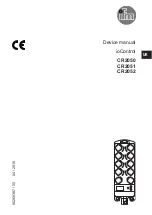
16
16
ENGLISH
6. SPECIFIC RISKS
Braking system failure
May occur due to braking system deficien-
cies or bad installation. If it stops working
it could cause a serious risk due to the rai-
sed load being out of control and may injure
users or hit materials next to the tower.
Loss of stability
If the tower is placed on a sloping ground or
a surface that is not completely flat, there is a
risk of losing stability which would lead to a
90º overturn with risk of serious injuries for
workers.
Objects dropping to a different level
As an elevation equipment and due to its
working height, there is a serious risk of
raised objects dropping to a different level,
either due to securing mechanism failure,
part wear, dirt, etc., or incorrect use of the
lifting tower (E.g.: for goods over the maxi-
mum load allowed). Sudden drop of raised
goods implies a serious risk for the worker.
Knocks and/or contusions due to objects
This risk only occasionally causes an accident
to the worker running the operation due to
his location during the elevation process; the
risk of knocks from a raised element is more
likely to affect people walking by or whose
workplace is next to the lifting tower.
Its origin may be due to a loss of stability,
malfunctioning of structural elements, safety
systems, securing systems, etc.
7. PREVENTION SYSTEMS
About braking system failure
Equip with winch complying with regula-
tions metioned in the DGUV Rule 115-002,
DGUV 17&18, directive, specially DIN EN
ISO 12100:2011-03 and DIN EN ISO 12100-
1:2004-04.
About loss of stability
Maintenance of lifting tower stability must
basically be as per the following measures:
• Professionalization, training and risk
awareness of lifting tower users.
• Equip with different safety devices and ad-
vices from the manufacturer to reinforce sta-
bility, as:
- Safety pins which secure the lifting tower
once raised.
- Bubble level to help vertical adjustment.
- Maximum load specification that the lifting
tower can raise.
- Maximum slope specification which the lif-
ting tower can access safely.
About objects falling to a different level,
knocks and/or contusions with objects
The risk of objects falling to a different level
can be prevented by using homologated safe-
ty elements, e.g., a safety pin which fixes the
inner profile of the lifting tower in its wor-
king position, so the cable does not support
load and guaranteeing the impossibility of a
drop. In the event of cable breakage, the bra-
king system will act automatically. Further-
more, if steel elements have been zinc coated
it protects the entire unit from oxidation and
corrosion.
These risks can also be minimised with co-
rrect lifting tower maintenance. The user
must perform periodical inspections on sa-
fety elements and make the necessary repairs
in case deficiencies are detected.
Moreover, the consequences of these risks
can be reduced limiting an access area to the
lifting tower and with a correct training of
personnel.
About noise emissions
This equipment doesn’t produce more than
80 dB.









































